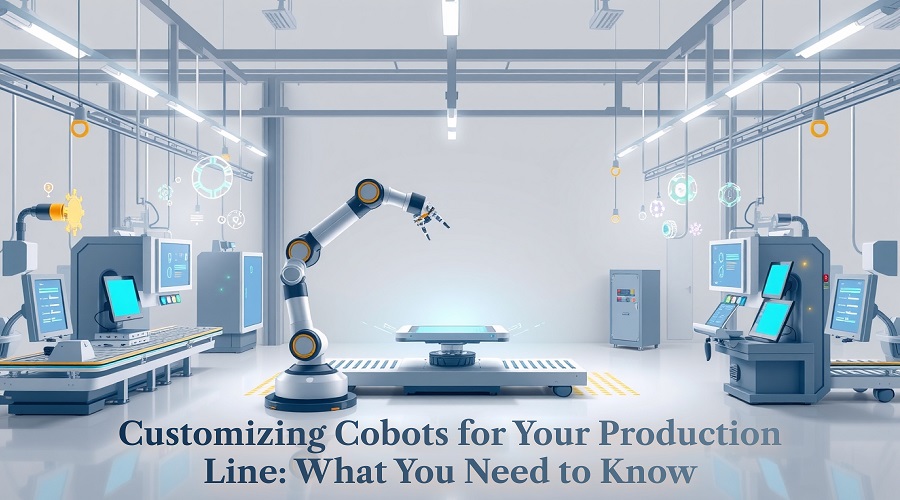In today’s fastmoving manufacturing world, staying competitive means doing more than just automating. It is about creating a production line that can adapt quickly, work safely, and maintain top quality. This is where Cobots, or collaborative robots, come in. Unlike traditional robots that require heavy barriers and complex programming, these machines are designed to work alongside humans, making operations more flexible and efficient.
But simply adding a cobot to your floor is not enough, customizing it to fit your specific processes is the real game changer. In this blog, we will explore why customization matters, what benefits it brings, and how you can integrate these smart helpers into your production line successfully.
What Are Cobots and Why They Matter
A cobots (collaborative robot) is a compact automated arm designed to work safely alongside humans, without heavy cages or barriers. Unlike traditional robots that require expert programmers and isolated work cells, Cobots are plug and play and easy to reprogram for new tasks. The global market for these machines reached about $1.2 billion in 2023 and is projected to grow to nearly $30 billion by 2035, at a compound annual growth rate of 34.5 %.
How to Customize Cobots for Your Line
- Assess Your Production Needs
Start by mapping repetitive or dangerous tasks. Is it bolting, packaging, welding, or inspection? Different applications call for different tooling and programming approaches.
- Choose the Right Payload and Reach
Select a model based on weight it must lift and reach area. Some examples: Universal Robots UR3 handles up to 3 kg, UR5 up to 5 kg, UR10 up to 10 kg; newer models go up to 30 kg payload.
- Integrate Sensors and Vision Systems
Adding machine vision cameras allows Cobots to inspect products or guide precise placement. Vision based safety monitoring can map 3D interaction zones for better safety analysis and performance review.
- Use Modular Tooling and Software
Custom end effectors and modular attachments let you reconfigure quickly. Plug and play programming tools now let nonexperts teach new tasks using simple gestures or trigger action logic via live systems.
- Leverage AI and Adaptive Control
Some Cobots integrate adaptive collaborative control: shared autonomy allows robot and human to share decision making. Large language model enabled frameworks now let operators give voice commands to guide robot assembly tasks in real time.
- Pilot and Train Users
Always pilot on a small section of the line before scaling. Track metrics like cycle time, errors, uptime, and operator workload. Training your team on programming and supervising Cobots ensures smoother adoption.
Key Benefits of Customized Cobots
- Flexibility and Speed to Switch Tasks
Custom configured Cobots can be repurposed quickly. For example, a model fitted with a screwdriver tool today might switch tomorrow to pick and place or inspection. This adaptability is vital in low volume, high mix production environments.
- Improved Safety and Human Comfort
Sensorequipped Cobots sense nearby humans and automatically slow or stop if someone enters the workspace. That makes them ideal for working side by side without complex fencing enhancing both safety and floor space efficiency. Custom safety systems (like vision based monitoring) further help reduce risk and diagnostic errors.
- Reduced Errors and Higher Quality
When outfitted with vision tools or precision end effectors, Cobots can inspect parts or assemble components more consistently than manual methods, leading to fewer defects and improved product quality. Some manufacturers report as much as a 50 % reduction in errors after deploying collaborative arms.
- Data Collection and Continuous Improvement
Modern Cobots collect rich data on cycle times, production rates, and tool performance. That data helps plant managers identify bottlenecks, optimize scheduling, and predict maintenance needs.
- Better Workforce Engagement
Rather than replacing people, Cobots free them up from repetitive or heavy tasks. Workers can focus on highervalue jobs like process oversight or quality control. Evidence shows deployment opens opportunities for upskilling and new roles.
Sample Impact: Real World Example
At a food manufacturing smart factory in Australia, collaborative arms and autonomous vehicles doubled production capacity and freed up staff to take higher level tasks. Workers were retrained, and new jobs were created as part of the upgrade to a data driven floor plan.
Final Thoughts
Customizing Cobots thoughtfully can transform your production line boosting flexibility, safety, quality, and data insight, while engaging your workforce in higher value roles. With proper task analysis, tooling selection, sensor integration, and user training, these collaborative machines can become powerful partners on your shop floor. The future of manufacturing is humanrobot teamwork, powered by smart customization.
Let me know if you’d like help planning a pilot or selecting the right Cobots for your specific line.
Ready to streamline your academic journey? Just like customizing cobots for efficiency, our Research Assistant services help you optimize ideas into structured outcomes. From Synopsis Writing to detailed research support, we ensure precision, clarity, and originality customized to your needs. Take the next step toward academic excellence connect with us today!
FAQs
1. What industries benefit most from Cobots customization?
Manufacturing sectors with small batches or high complexity-electronics, automotive components, food packaging, plastics, pharmaceuticals see the biggest gains with custom Cobots.
2. How long before I see ROI?
Because of low installation costs and quick setup, many companies report return on investment within six to twelve months thanks to lower labor costs and fewer defects.
3. Is special programming expertise required?
Not always. Many newer systems offer intuitive touchscreen interfaces or gesturebased programming. Triggeraction frameworks let line workers configure simple tasks without coding experience.
4. Are Cobots safe to work alongside people?
Yes. Builtin force and vision sensors limit speed or stop motion if humans get too close. Enhanced systems can reconstruct the interaction zone in 3D to monitor and review incidents.
5. How can customization adapt as needs change?
Modular components, flexible programming tools, and AI driven control mean Cobots can be reconfigured for new tasks quickly, often within hours or days rather than weeks.





Comments